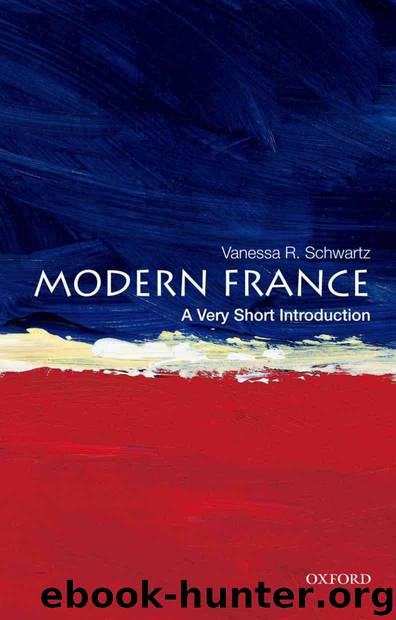Modern France: A Very Short Introduction (Very Short Introductions) by Schwartz Vanessa R

Author:Schwartz, Vanessa R. [Schwartz, Vanessa R.]
Language: eng
Format: mobi, epub
Publisher: Oxford University Press
Published: 2011-09-11T16:00:00+00:00
Novel technologies of representation
Photography, which made a fledgling appearance in the late 1820s in the experiments of inventor Nicéphore Niépce, became firmly entrenched as a process by Louis Daguerre in 1838. He created the “daguerreotype,” a positive image taken directly from the dark chamber of a camera obscura. France declared the invention of photography as a gift to the world in a joint meeting of the Academy of Science and the Academy of Fine Arts in 1839. In exchange, Daguerre and the Niépce’s heirs were given pensions for life by the French state. Photography lent credence to a new fantasy of archiving modern urban life as long exposure times favored representations of place. Eventually, the portrait would join landscape as the genres most favored in the new proliferation of images. In addition, photography’s limited ability to truthfully capture life as it actually transpired was actively debated then and continues to this day.
Photography nevertheless contributed to the process by which nineteenth-century Parisian life became the stuff of myth through the dissemination of images. Haussmann documented his renovations by hiring Charles Marville to photograph Paris before and after the demolitions. City views already had a rich iconographic tradition in woodcuts, engravings, and lithographs. Photography would soon follow, especially once postcards became widely available in the last decade of the nineteenth century. Postcard series consisted of as many as 10,000 views of the modern city they idealized, including its charming corners of “Old Paris.” From the now-well-known images produced by Eugène Atget for the city government to the work of the Surrealist photographers Man Ray and Brassaï to the photojournalists of everyday life Robert Doisneau and Henri Cartier-Bresson, so many views of Paris dispersed by the burgeoning press and published in thematic photographic books of Parisian life reinforced the act of consuming the city as an image. Representing Paris in literature had already become so frequent that Balzac called it the “city of a hundred thousand novels.” Paintings and photos also repeated and contributed to the heroic trope that the city was a miraculous miniature version of the world.
By the time narrative sound films became popular in the 1920s and ’30s, they developed a slightly different optic on Paris. Steeped more explicitly in the culture of “Paris populaire,” the films depicted working-class heroes, taxi drivers, and loose women, and were set in as many garret maids’ rooms and shady hotels as glamorous nightclubs and elegant cafés. Even one of the most highly valued international film stars of the era, Maurice Chevalier, had an everyman act, complete with the iconic caps and rolled letter r’s, which stood as proof of his birth in the Parisian working-class neighborhood of Ménilmontant.
Photography and the newer medium of film, which had its first public screening in Paris’ Salon Indien at the Grand Café in 1895, also became embedded in the urban fabric—not so much for the views taken but for the remarkable saturation of the urban milieu by photo studios and venues for the exhibition of film. From
Download
Modern France: A Very Short Introduction (Very Short Introductions) by Schwartz Vanessa R.epub
This site does not store any files on its server. We only index and link to content provided by other sites. Please contact the content providers to delete copyright contents if any and email us, we'll remove relevant links or contents immediately.
| Belgium | France |
| Germany | Great Britain |
| Greenland | Italy |
| Netherlands | Romania |
| Scandinavia |
Room 212 by Kate Stewart(5071)
The Crown by Robert Lacey(4761)
Endurance: Shackleton's Incredible Voyage by Alfred Lansing(4719)
The Iron Duke by The Iron Duke(4320)
The Rape of Nanking by Iris Chang(4167)
Joan of Arc by Mary Gordon(4053)
Killing England by Bill O'Reilly(3969)
Say Nothing by Patrick Radden Keefe(3937)
I'll Give You the Sun by Jandy Nelson(3394)
Shadow of Night by Deborah Harkness(3326)
Hitler's Monsters by Eric Kurlander(3291)
Mary, Queen of Scots, and the Murder of Lord Darnley by Alison Weir(3171)
Blood and Sand by Alex Von Tunzelmann(3165)
Eleanor & Park by Rainbow Rowell(3112)
Darkest Hour by Anthony McCarten(3096)
Margaret Thatcher: The Autobiography by Thatcher Margaret(3046)
Book of Life by Deborah Harkness(2893)
Red Famine: Stalin's War on Ukraine by Anne Applebaum(2890)
The One Memory of Flora Banks by Emily Barr(2829)
